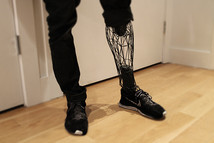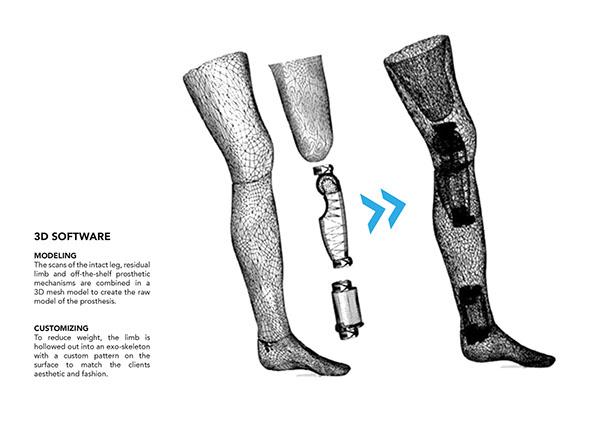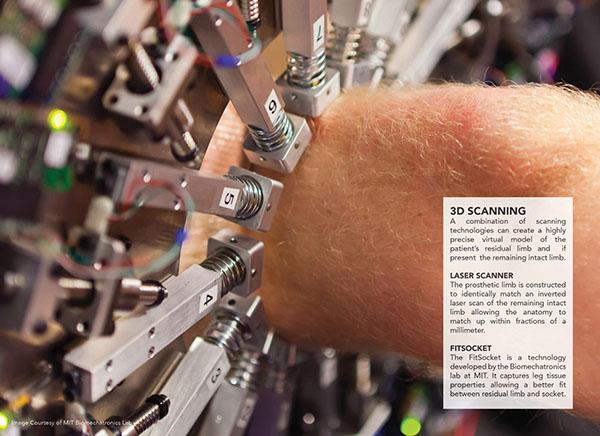/ News

Industrial Designer Creates The ‘Exo’ 3D Printed Prosthetic Leg with Aesthetics in Mind
Brooklyn, New York industrial designer William Root is using 3D scanning, modeling, and printing to create customized prosthetic limbs. Currently, he is working on the prototype for what he calls the “Exo-Prosthetic Leg.”
Each year in the US around 185,000 amputations are performed, 90% of which involve the loss of lower extremities. There are approximately 2 million amputees in the country. The financial, physical, and psychological effects of such a procedure can and often do cause additional trauma to patients, as does adapting to an awkward and sometimes ill-fitting new limb.
Prosthetic limbs range in functionality, appearance and, of course, expense. The most expensive prosthetics are the robotic ones that are prohibitively expensive to most amputees but are quite remarkable in their intricacy and capacity to restore almost complete function of a limb to amputees. As the technology improves and manufacturing of such high-tech prostheses becomes affordable, probably via 3D printing whenever design aspects permit, these devices will become more affordable to people with amputations.
Another problem with the current system of prosthetic production is the customization process of traditional prosthetic limbs, which is typically time consuming, requiring a painstaking measuring process and often numerous fittings and adjustments. Ultimately, amputees must make extreme adjustments in order to adapt to prosthetic limbs, which are often not particularly attractive or lifelike.
Understandably, form has been considered secondary to function where prosthetic devices are concerned. Root, however, doesn’t think that appearance needs to suffer for the sake of increased function. Root has designed the Exo-Prosthetic Leg, which is produced using 3D scanning of the residual and the remaining limb to create a precisely matched and properly fitting prosthetic replica.
Following the 3D scanning process, Root creates a model for the prosthetic leg using 3D modeling software. To aid in precise fitting, FitSocket technology, which was developed in the Biomechatronics lab at MIT, is used to analyze the tissue properties of the leg (or, ultimately, other missing extremities). Measurements are taken that fit down to the millimeter so patients do not experience some of the more awkward and physically uncomfortable effects of wearing and managing prosthetic devices.
A 3D mesh model of the prosthesis is produced and is combined with standard, manufactured prosthetic mechanisms, which fit inside the Exo-Prosthetic Leg. Root can customize the prostheses by using different patterns with the super lightweight but durable titanium mesh of the prosthetic’s surface. Customers can also choose a color they prefer. Root envisions the Exo-Prosthetic Leg as scaffolding for customers who’d like to cover the artificial limb with a custom-designed silicone sleeve.

In addition to 3D printing the attractive design of the mesh surface, Root prints customized connectors for the separate components, that fit within the prosthesis. The Exo-Prosthetic Leg is still in the development phase as Root refines its design to produce a fully-functional prototype. At all stages, 3D technology has been key to the project, which is garnering a great deal of attention and clearly provides real promise for millions of people.
Let us know what you think of this artistic and functional design at the Exo-Prosthetic Leg forum thread at 3DPB.com.
Source: http://3dprint.com/32848/exo-prosthetic-leg/
/ About us
Founded by Russian entrepreneur Dmitry Itskov in February 2011 with the participation of leading Russian specialists in the field of neural interfaces, robotics, artificial organs and systems.
The main goals of the 2045 Initiative: the creation and realization of a new strategy for the development of humanity which meets global civilization challenges; the creation of optimale conditions promoting the spiritual enlightenment of humanity; and the realization of a new futuristic reality based on 5 principles: high spirituality, high culture, high ethics, high science and high technologies.
The main science mega-project of the 2045 Initiative aims to create technologies enabling the transfer of a individual’s personality to a more advanced non-biological carrier, and extending life, including to the point of immortality. We devote particular attention to enabling the fullest possible dialogue between the world’s major spiritual traditions, science and society.
A large-scale transformation of humanity, comparable to some of the major spiritual and sci-tech revolutions in history, will require a new strategy. We believe this to be necessary to overcome existing crises, which threaten our planetary habitat and the continued existence of humanity as a species. With the 2045 Initiative, we hope to realize a new strategy for humanity's development, and in so doing, create a more productive, fulfilling, and satisfying future.
The "2045" team is working towards creating an international research center where leading scientists will be engaged in research and development in the fields of anthropomorphic robotics, living systems modeling and brain and consciousness modeling with the goal of transferring one’s individual consciousness to an artificial carrier and achieving cybernetic immortality.
An annual congress "The Global Future 2045" is organized by the Initiative to give platform for discussing mankind's evolutionary strategy based on technologies of cybernetic immortality as well as the possible impact of such technologies on global society, politics and economies of the future.
Future prospects of "2045" Initiative for society
2015-2020
The emergence and widespread use of affordable android "avatars" controlled by a "brain-computer" interface. Coupled with related technologies “avatars’ will give people a number of new features: ability to work in dangerous environments, perform rescue operations, travel in extreme situations etc.
Avatar components will be used in medicine for the rehabilitation of fully or partially disabled patients giving them prosthetic limbs or recover lost senses.
2020-2025
Creation of an autonomous life-support system for the human brain linked to a robot, ‘avatar’, will save people whose body is completely worn out or irreversibly damaged. Any patient with an intact brain will be able to return to a fully functioning bodily life. Such technologies will greatly enlarge the possibility of hybrid bio-electronic devices, thus creating a new IT revolution and will make all kinds of superimpositions of electronic and biological systems possible.
2030-2035
Creation of a computer model of the brain and human consciousness with the subsequent development of means to transfer individual consciousness onto an artificial carrier. This development will profoundly change the world, it will not only give everyone the possibility of cybernetic immortality but will also create a friendly artificial intelligence, expand human capabilities and provide opportunities for ordinary people to restore or modify their own brain multiple times. The final result at this stage can be a real revolution in the understanding of human nature that will completely change the human and technical prospects for humanity.
2045
This is the time when substance-independent minds will receive new bodies with capacities far exceeding those of ordinary humans. A new era for humanity will arrive! Changes will occur in all spheres of human activity – energy generation, transportation, politics, medicine, psychology, sciences, and so on.
Today it is hard to imagine a future when bodies consisting of nanorobots will become affordable and capable of taking any form. It is also hard to imagine body holograms featuring controlled matter. One thing is clear however: humanity, for the first time in its history, will make a fully managed evolutionary transition and eventually become a new species. Moreover, prerequisites for a large-scale expansion into outer space will be created as well.
Key elements of the project in the future
• International social movement
• social network immortal.me
• charitable foundation "Global Future 2045" (Foundation 2045)
• scientific research centre "Immortality"
• business incubator
• University of "Immortality"
• annual award for contribution to the realization of the project of "Immortality”.





 LinkedIn
LinkedIn
 LiveJournal
LiveJournal
 Google
Google
 Twitter
Twitter
 Facebook
Facebook
 Я.ру
Я.ру
 ВКонтакте
ВКонтакте
 Mail.ru
Mail.ru